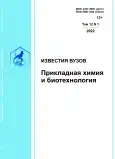Thermochemical liquefaction of wheat straw in sub- and supercritical tetralin
- Authors: Evstaf‘ev S.N.1, Fomina E.S.1, Tiguntceva N.P.1
-
Affiliations:
- Irkutsk National Research Technical University
- Issue: Vol 12, No 1 (2022)
- Pages: 160-166
- Section: Brief communication
- URL: https://ogarev-online.ru/2227-2925/article/view/301127
- DOI: https://doi.org/10.21285/2227-2925-2022-12-1-160-166
- ID: 301127
Cite item
Full Text
Abstract
About the authors
S. N. Evstaf‘ev
Irkutsk National Research Technical University
Email: esn@istu.edu
E. S. Fomina
Irkutsk National Research Technical University
Email: lenafomina1982@yandex.ru
N. P. Tiguntceva
Irkutsk National Research Technical University
Email: tignadezhda@yandex.ru
References
- Kajimoto O. Solvation in supercritical fluids: its effects on energy transfer and chemical reactions // Chemical Reviews. 1999. Vol. 99, no. 2. P. 355– 390. https://doi.org/10.1021/cr970031l.
- Sun Y., Cheng J. Hydrolysis of lignocellulosic materials for ethanol production: a review // Bioresource Technology. 2002. Vol. 83, no. 1. P. 1–11. https://doi.org/10.1016/s0960-8524(01)00212-7.
- Евстафьев С. Н., Чечикова Е. В. Превращения полисахаридов соломы пшеницы в динамических условиях процесса субкритического автогидролиза // Химия растительного сырья. 2015. N. 1. С. 41–49. https://doi.org/10.14258/jcp rm.201501426.
- Perkins G., Batalha N., Kumar A., Bhaskar T., Konarova M. Recent advances in liquefaction technologies for production of liquid hydrocarbon fuels from biomass and carbonaceous wastes // Renewable and Sustainable Energy Reviews. 2019. Vol. 115. P. 109400. https://doi.org/10.1016/j.rser.2019.109400.
- de Caprariis B., De Filippis P., Petrullo A., Scarsella M. Hydrothermal liquefaction of biomass: influence of temperature and biomass composition on the bio-oil production // Fuel. 2017. Vol. 208. P. 618–625. https://doi.org/10.1016/j.fuel.2017.07.054.
- Hewetson B. B., Zhang X., Mosier N. S. Enhanced acid-catalyzed biomass conversion to hydroxymethylfurfural following cellulose solvent-and organic solvent-based lignocellulosic fractionation pretreatment // Energy & Fuels. 2016. Vol. 30. P. 9975– 9977. https://doi.org/10.1021/acs.energyfuels.6b01910.
- Ma P., Gao Y., Zhai H. Fractionated wheat straw lignin and its application as antioxidant // BioResources. 2013. Vol. 8, no. 4. P. 5581–5595. https://doi.org/10.15376/biores.8.4.5581-5595.
- Chesi C., de Castro I. B. D., Clough M. T., Ferrini P., Rinaldi R. The influence of hemicellulose sugars on product distribution of early-stage conversion of lignin oligomers catalysed by Raney nickel // ChemCatChem. 2016. Vol. 8, no. 12. P. 2079–2088. https://doi.org/10.1002/cctc.201600235.
- Schutyser W., Van den Bosch S., Renders T., De Boe T., Koelewijn S.-F., Dewaele A., et al. Influence of bio-based solvents on the catalytic reductive fractionation of birch wood // Green Chemistry. 2015. Vol. 17, no. 11. P. 5035–5045. https://doi.org/ 10.1039/c5gc01442e.
- Galkin M. V., Smit A. T., Subbotina E., Artemenkon K. A., Bergquist J., Huijgen W. J. J., et al. Hydrogen-free catalytic fractionation of woody biomass // ChemSusChem. 2016. Vol. 9, no. 23. P. 3280–3287. https://doi.org/10.1002/cssc.201600648.
- Parsell T., Yohe S., Degenstein J., Jarrell T., Klein I., Gencer E., et al. A synergistic biorefinery based on catalytic conversion of lignin prior to cellulose starting from lignocellulosic biomass // Green Chemistry. 2015. Vol. 17, no. 3. P. 1492–1499. https://doi.org/10.1039/C4GC01911C.
- Sannigrahi P., Ragauskas A. J. Characterization of fermentation residues from the production of bio-ethanol from lignocellulosic feedstocks // Journal of Biobased Materials and Bioenergy. 2011. Vol. 5, no. 4. P. 514–519. https://doi.org/10.11 66/jbmb.2011.1170.
- Kleinert M., Barth T. Towards a lignocellulosic biorefinery: direct one–step conversion of lignin to hydrogen–enriched bio–fuel // Energy & Fuels. 2008. Vol. 22, no. 2. P. 1371–1379. https://doi. org/10.1021/ef700631w.
- Wang Y., Wang H., Lin H., Zheng Y., Zhao J., Pelletier A., et al. Effects of solvents and catalysts in liquefaction of pinewood sawdust for the production of bio-oils // Biomass and Bioenergy. 2013. Vol. 59. P. 158– 167. https://doi.org/10.1016/j.biombioe.2013.10.022.
- Sangon S., Ratanavaraha S., Ngamprasertsith S., Prasassarakich P. Coal liquefaction using supercritical toluene–tetralin mixture in a semicontinuous reactor // Fuel Processing Technology. 2006. Vol. 87, no. 3. P. 201–207. https://doi. org/10.1016/J.FUPROC.2005.07.007.
- Koriakin A., Nguyen H. V., Kim D.-W., Lee C.-H. Thermochemical decomposition of microcrystalline cellulose using sub- and supercritical tetralin and decalin with Fe3O4 // Industrial & Engineering Chemistry Research. 2015. Vol. 54, no. 18. P. 5184–5194. https://doi.org/10.1021/acs.iecr.5b00763.
- Kundu R., Ramsurn H. Kinetic study of noncatalytic dissolution of cellulose biochar in hydrogen donor solvent // ACS Sustainable Chemistry & Engineering. 2020. Vol. 8, no. 31. P. 11606–11617. https://doi.org/10.1021/acssuschemeng.0c02907.
- Koriakin A., Moon S., Kim D.-W., Lee C.-H. Liquefaction of oil palm empty fruit bunch using suband supercritical tetralin, n-dodecane, and their mixture // Fuel. 2017. Vol. 208. P. 184–192. https://doi. org/10.1016/j.fuel.2017.07.010.
- Kim D.-W., Lee C.-H. Efficient conversion of extra-heavy oil into distillates using tetralin/activated carbon in a continuous reactor at elevated temperatures // Journal of Analytical and Applied Pyrolisys. 2019. Vol. 140. P. 245–254. https://doi.org/10.1016/ J.JAAP.2019.04.001.
- Фомина Е. С., Евстафьев С. Н. Сравнительный анализ состава низкомолекулярных продуктов сверхкритической экстракции соломы пшеницы этанолом и диметилкарбонатом // Известия вузов. Прикладная химия и биотехнология. 2018. Т. 8. N 2. С. 9–18. https://doi.org/10.21 285/2227-2925-2018-8-2-9-18.
Supplementary files









